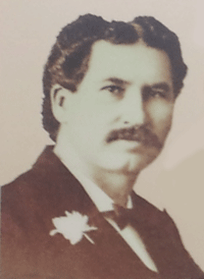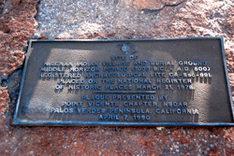Carmichael History
“Lots for Sale in Carmichael, California – 10 acre tracts for $1,500 with 10 percent down on terms of $10 a month at 6 percent interest”
That advertisement appeared in the early 1900’s. It continued: “In the shelter of rolling foothills secure from frosts, the Woods hereabouts are stocked with game birds, quail etc., and the streams are stocked with trout for rod and ducks for gun.”
The man selling the lots was Dan Carmichael, the community’s founder and its first developer.
“Big Real Estate Deal” was the headline in the Oct. 1, 1909 Folsom-Telegraph newspaper. The story was about Daniel Carmichael who purchased 2,000 acres of “land composed of hills and dales dotted with noble oaks.” It was thought he paid between $150,000 and $200,000 for the land.

alled Carmichael Colony No. I, the 2,000 acres was once part of the 20,000 acre Rancho San Juan Mexican grant made to Joel P. Dedmond in 1844. The colony’s boundaries were Lincoln Avenue to the north, San Juan Avenue to the east, The American River and Deterting Ranch (now Ancil Hoffman Park) to the south and Fair Oaks Boulevard to the west.
Carmichael later bought another 1,000 acres that he called Carmichael Colony No. 2. It bordered the first colony to the east and Walnut Avenue to the west; the southern boundary was Arden Way with Sutter Avenue to the north. This new territory was previously part of the 44,000 acre Del Paso Rancho Mexican grant made to Eliab Grimes, in 1844. Before Carmichael acquired it, James Ben, Ali Haggin, and his Daniel Carmichael associates bred and raised racehorses, including Kentucky Derby winner Salvatore, on a farm located where Del Dayo Estates now stands.
Carmichael laid out the two colonies into 10 acre tracts and sold them for $1,500 each. Daniel W. Carmichael born in 1867 in Atlanta, Georgia came to California in 1885. After a decade spent at various jobs such as ranching and bookkeeping, he organized the real estate firm of Curtis, Carmichael and Brand. This business, established in 1895 in the City of Sacramento, was devoted to the acquisition and development of the Sacramento Valley.
Carmichael bought out his partners in 1900 and the firm became known as the Carmichael Company. Carmichael also invested in early oil wells in Kern County through his firm, the Sacramento Oil Company.
Carmichael was also active in Sacramento politics and was elected treasurer for the city of Sacramento in 1885 and in 1903 was elected Sacramento County treasurer. He was mayor of Sacramento from 1917-19. He also served as a director for the Sacramento Chamber of Commerce for 18 years and was president from 1910-13.
His other civic activities included membership in the Masons, Odd Fellows, Elk, and the Sutter Club. The State Realty Federation of California elected him president in 1910.
In 1892 Carmichael was married in Sacramento to Myrtle Robb, the daughter of Charles S. Robb, a well-known Railroad man. The Carmichael’s never lived in the colonies he developed; their home was on 23rd Street in Sacramento. Apparently, Carmichael left the Sacramento area around 1923 and reportedly traveled to England but returned to live In San Francisco. Daniel Carmichael died in San Francisco in 1936. He was 70 years old and penniless.
First Settlers

The first known settlers in the area were the Maidu Indians dating back to 1,000 B.C. They were forced to leave the area when white settlers arrived in the early 1800’s. The first new settlers of Carmichael were Charles W. and Mary A. Deterding. In 1907 they purchased a 425 acre site along the north bank of the American River. The Deterding Ranch is now Ancil Hoffman Park.
Mary was one of seven children whose parents were John and Elizabeth Shields. They lived on a farm at Mills Station then known as Hangtown Crossing (Rancho Cordova, today). She attended St. Joseph’s Convent in Sacramento and married Charles W. Deterding soon after graduation.
Her brother, Peter J. Shields became a Sacramento judge and the Deterding’s son, Charles W. Deterding Jr. served as Sacramento County executive in the 1940’s. Their other son, J. R. Deterding operated a plumbing supply company and their daughter, Mae, married A. D. (Arch) McDonell. The McDonell’s still live in Carmichael today.
She was a past president of the Thursday Club of Fair Oaks, was a member of St. Mel’s Alter Society and was the first president of the Carmichael Improvement Club. An active Democrat, she died Sept. 27,1940 at the age of 80.
By 1927, there were about 300 families living in Carmichael and the 1930 population was listed at 700. Nearly 2,000 people lived in the area by 1940 and the population was 4,499 in 1950 according to U.S. Census Bureau figures.
The Area Grew

Prior to 1940, the community had no central business district. The Red & White Store supplied meat and groceries at the corner of California and Fair Oaks Boulevard and there was a gas station at the triangle a Fair Oaks and Manzanita. Another grocery store, Arrowhead, was on the southeast corner at Fair Oaks Boulevard and Palm Avenue and Dan Donovan operated a bar, restaurant and grocery store at Fair Oaks and Garfield.
As Carmichael grew, businesses clustered around Palm Avenue and Marconi Avenue. Bob Marchal built the Carmichael Shopping Center on the southwest corner. One business, the Rose Tree remains in Carmichael today.
Carmichael’s first bank – The Suburban Bank – opened In the 1940’s after Marchal drove to Washington, D.C. to obtain a bank charter. Crocker Bank took over the service in the 1950’s. Carmichael’s first large shopping complex-Crestview Center built In 1963 by Richard and Dea Holesapple.
Carmichael residents had telephone service beginning in 1915 with a I0 party line through Fair Oaks. There was a toll charged to call Sacramento. A direct line was installed in 1933.
Today, Carmichael, having grown to a population of 65,000, is a community immersed in a still expanding unincorporated suburban area of 550,000 people
